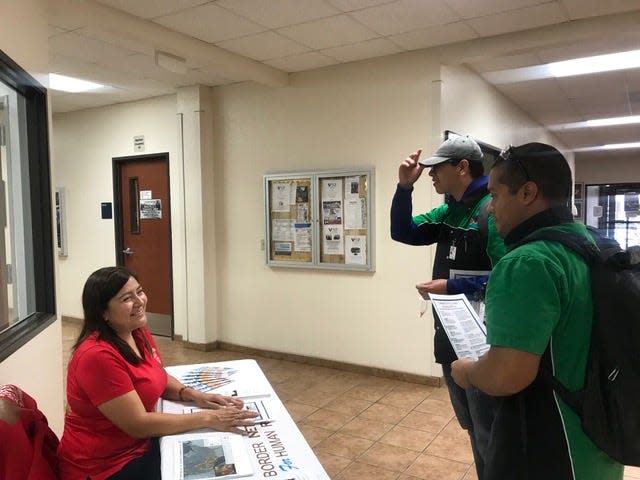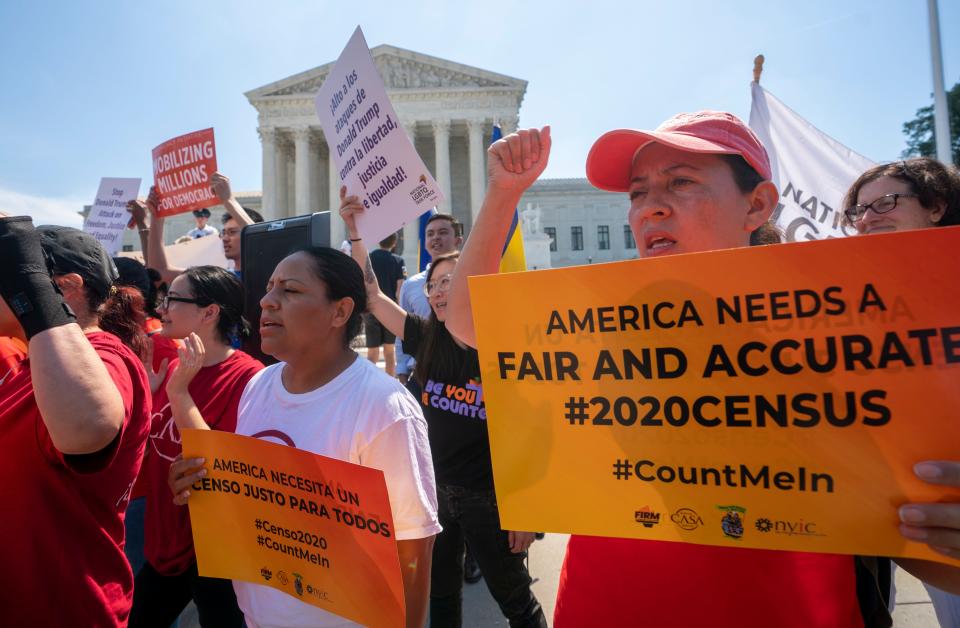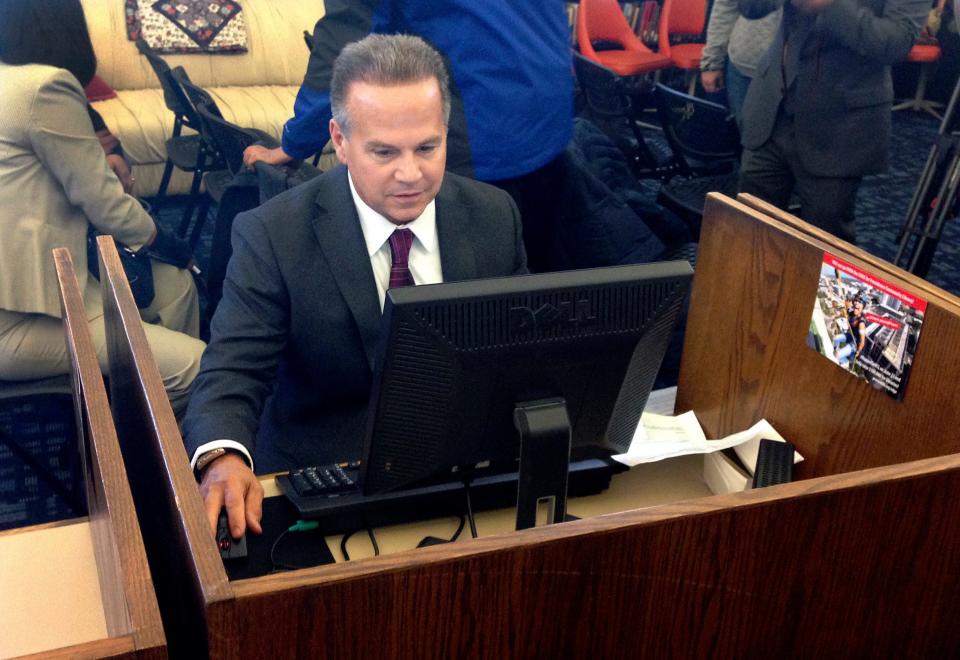2020 census may have massively undercounted Black population, analysis shows
- Oops!Something went wrong.Please try again later.
The 2020 census may have undercounted the nation's Black population by as much as 7%, or more than three times the rate of the 2010 Census, according to simulations conducted by an independent researcher.
Should they bear out, the projections could pose significant ramifications for the nation’s Black communities. Census figures chart the course for everything from political representation, health statistics and allocation of infrastructure and health care funding.
“This is unfortunate, but I’m not surprised,” said Marc Morial, president and CEO of the National Urban League. “The census bureau did not adequately execute the door-knocking phase of the process. All signals pointed to an undercount.”
Undercounts have previously been reported by the Census, especially in communities of color. Lower homeownership rates in these communities, as well as mistrust of government officials who don't look like them, have been linked to underreporting in the past.
Video: 2020 census marks decline in white population
The Trump administration's handling of the count in 2020 as the COVID-19 pandemic spread across the nation also might have contributed to fewer Americans of color filling out the census. Trump unsuccessfully sought to exclude undocumented immigrants from the count. And census workers curtailed efforts to go door to door to do the count because of the pandemic.
The National Urban League last year sued the bureau in an effort to fight the Trump administration’s decision to abandon census door-knocking efforts after the deadline for those efforts had been extended because of the pandemic.
“The census bureau was interfered with politically,” Morial said. “They should have extended it as long as possible to knock on every door.”

Experts had warned that communities of color could be significantly undercounted particularly in rural and urban areas that the census bureau characterizes as challenging to count. Self-reporting in those areas is much lower than the national average.
Census numbers affect access to federal funding, including for Medicare and Medicaid, road construction, Section 8 housing vouchers and the Supplemental Nutrition Assistance Program (SNAP).
The 2020 census estimates roughly 12.4% of Americans are Black.
“This undercount could have wide-ranging consequences for communities of color,” said Rep. Steven Horsford, D-Nevada, chair of the Congressional Black Caucus’ 2020 Census Task Force. “The foundation of our democracy and fair distribution of taxpayer dollars depend on a fair, accurate census count.”
As census challenges grew, so did worries about accuracy
Connie Citro, a semi-retired senior scholar at the Committee on National Statistics at the National Academies of Sciences, Engineering and Medicine, carried out the simulations on her own initiative after noting reports indicating low numbers of self-response rates to the census in areas with high numbers of low-income, Black and Latino residents.
That, in combination with challenging data-collection circumstances, such as the pandemic and the Trump administration’s controversial but ultimately abandoned push to ask respondents about citizenship status, seemed to threaten an unusually high undercount for 2020, Citro said.
“For at least a couple (of) years now, people have been worried about this census,” she said. “The bureau deserves every credit for getting this census done, but it would be surprising if it didn’t have some quality issues compared to 2010, because this was a unique set of circumstances.”

Citro’s simulations examined both census respondents who checked Black and no other race as well as those who checked Black in combination with “some other race,” using low, middle and high population projections released by the census bureau in December.
Based on her simulation, Citro estimated that the census’ 2020 count for those who checked Black and no other race could range between 3.24 and 7.25% below the actual number. That figure was estimated at just 2.3% in 2010.
For those who checked Black and “some other race,” Citro’s simulation projected anywhere from a slight overcount to an undercount of 4.36%. In 2010, that category was ultimately estimated to have been undercounted by 1%.
Citro’s estimates were modeled on figures compiled by the census bureau for its 2010 count. After seeing what percentage of those who responded “Some Other Race” ended up being categorized by the bureau as Black in the post-enumeration survey that traditionally follows the decennial census, she applied similar math to the bureau’s most recent projections.
“Essentially what I did is look at 2010 and how they distributed the 'Some Other Race' people, how many of them ended up as African American, and calculated,” she said. “It’s an approximation.”
Citro said she contacted the census bureau's demographics division to have someone review her calculations and was eventually connected with Eric Jensen, senior technical expert for demographic analysis for the bureau’s population division.
While the bureau is not endorsing her numbers, Citro said, “they said what I was doing was reasonable. We won’t know anything definitive for another year. But the results I got were in line with what I thought I might see.”
'This census hit a perfect storm'
Citro said her curiosity was piqued by various studies of self-response rates – in other words, individuals who submitted their own information as opposed to being interviewed by census takers – in the census’ roughly 73,000 census tracts.
Individuals were able to submit such information online, and Citro noticed large increases compared to 2010 in about 4,000 tracts where she said residents tend to be equipped with broadband capability – and significant decreases in about 8,000 tracts with high numbers of low-income Black and Latino residents, where such access was more cost-prohibitive.

Citro said areas with high rates of self-response are typically more accurately counted than those without, despite the bureau’s best efforts to follow up in the field with non-respondents. A landlord or family member visited by census workers might report two or three people living in a household when there are actually four or five, she said, making that process “proportionately more incomplete.”
“There are areas that historically harder to get complete counts for, and this has been true for as long as we’ve been doing this,” Citro said. “But on top of that, you had the citizenship issue, COVID and internet inequality. This census hit a perfect storm.”
Citro also projected that the 2020 census’ undercount of Black children under 18 could be about 10 times higher than in 2010’s slightly undercounted rate of 0.63%.
While the bureau’s post-enumeration survey, expected next year, should provide some clarity, Citro cautioned that that, too, could be fraught with uncertainty as it was conducted during the winter’s COVID surge, hampering responses.
Horsford, of the Congressional Black Caucus, said that should the estimates hold, federal and state leaders will need to be sensitive to how funding is allocated to adjust for the discrepancy.
“Going forward,” he said, “we need legislative remedies to prevent political interference in the Census and ensure that every person in the United States is counted.”
This article originally appeared on USA TODAY: 2020 census undercount of Blacks could be three times rate in 2010

